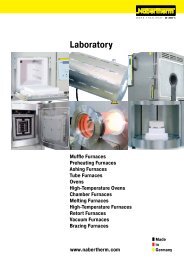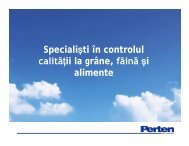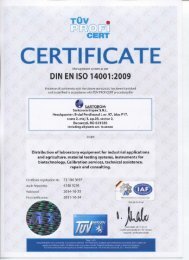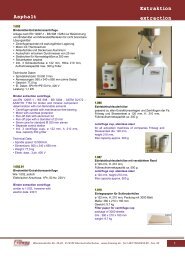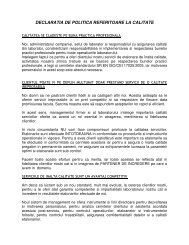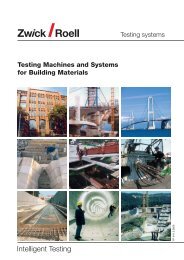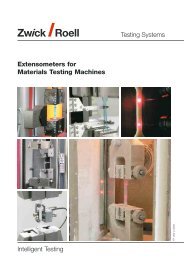ANALYSETTE 22 NanoTec - Fritsch - Malen en Zeven
ANALYSETTE 22 NanoTec - Fritsch - Malen en Zeven
ANALYSETTE 22 NanoTec - Fritsch - Malen en Zeven
You also want an ePaper? Increase the reach of your titles
YUMPU automatically turns print PDFs into web optimized ePapers that Google loves.
FRITSCH · LASER PARTICLE SIZER<br />
IDEAL FOR<br />
- MEASURING THE PARTICLE SIZE DISTRIBUTION<br />
OF SOLIDS AND SUSPENSIONS<br />
- MEASURING RANGE 0.01 – 2000 µm<br />
- PRODUCTION AND QUALITY CONTROL<br />
- RESEARCH AND DEVELOPMENT<br />
STATIC LASER SCATTERING
FRITSCH <strong>ANALYSETTE</strong> <strong>22</strong><br />
For over 25 years, FRITSCH has remained one step ahead in the area of laser<br />
particle sizing. In 1985, we revolutionised measurem<strong>en</strong>t precision by introducing the<br />
concept of laser diffraction in a converg<strong>en</strong>t laser beam with the pat<strong>en</strong>ted FRITSCH<br />
FRITSCH. ONE STEP AHEAD.<br />
measurem<strong>en</strong>t process. This process has now become the international standard for<br />
easy, fast and reliable particle size analysis. B<strong>en</strong>efi t from the practical experi<strong>en</strong>ce<br />
and technical superiority achieved in a quarter-c<strong>en</strong>tury of work in laser particle sizing.<br />
2
<strong>ANALYSETTE</strong> <strong>22</strong><br />
SIMPLE.<br />
FLEXIBLE.<br />
RELIABLE.<br />
The FRITSCH <strong>ANALYSETTE</strong> <strong>22</strong> <strong>en</strong>sures precise determination of particle sizes worldwide –<br />
in production and quality control as well as in research and developm<strong>en</strong>t. B<strong>en</strong>efit from its decisive<br />
advantages: extremely simple operation, short analysis times and consist<strong>en</strong>tly reproducible and<br />
reliable results. And of course getting the best value for your money.<br />
QUALITY AND TECHNOLOGY FROM GERMANY<br />
All key compon<strong>en</strong>ts of all FRITSCH Laser Particle Sizers are manufactured <strong>en</strong>tirely in Germany. The fi nal<br />
production takes place exclusively at our own plant at our headquarters in Idar-Oberstein. With strict<br />
quality controls and the special att<strong>en</strong>tion to detail of a traditional family-owned company. This you can<br />
really dep<strong>en</strong>d on.<br />
3
FRITSCH <strong>ANALYSETTE</strong> <strong>22</strong><br />
<strong>ANALYSETTE</strong> <strong>22</strong><br />
COMPACT SIZE –<br />
COMPACT PRICE<br />
YOUR ADVANTAGES<br />
Measuring range 0.01 – 2000 µm<br />
Short measuring time<br />
High measurem<strong>en</strong>t precision<br />
Consist<strong>en</strong>t reproducibility<br />
Reliable comparability<br />
User-fri<strong>en</strong>dly operation<br />
TWO MODELS FOR ALL APPLICATIONS<br />
MicroTec plus (0.08 – 2000 µm)<br />
<strong>NanoTec</strong> plus (0.01 – 2000 µm)<br />
0.08 2000<br />
Dry dispersion unit<br />
0.01 0.10 1 10 100 1000<br />
10000 (µm)<br />
Choose according to your needs: either the <strong>ANALYSETTE</strong> <strong>22</strong> MicroTec plus –<br />
the perfect all-round-laser with a measuring range of 0.08 – 2000 µm for all<br />
typical measurem<strong>en</strong>t tasks; or the <strong>ANALYSETTE</strong> <strong>22</strong> <strong>NanoTec</strong> plus, the high<strong>en</strong>d<br />
instrum<strong>en</strong>t for measurem<strong>en</strong>ts down to the nano range – for maximum<br />
precision and s<strong>en</strong>sitivity for the smallest particles through the measurem<strong>en</strong>t<br />
of the backward scattering in a third laser beam.<br />
Measuring unit<br />
4
FRITSCH-PLUS<br />
• Intellig<strong>en</strong>t modular design Each <strong>ANALYSETTE</strong> <strong>22</strong> consists of a compact measuring unit that<br />
can be quickly and easily combined with various dispersion units for dry respectively wet<br />
measurem<strong>en</strong>ts. This allows you to buy only what you need for your applications.<br />
• Practical fast-switch-system Quickly switch betwe<strong>en</strong> dispersion units by simply changing<br />
the cartridge containing the measuring cell.<br />
• Short measuring time The <strong>ANALYSETTE</strong> <strong>22</strong> completes most measurem<strong>en</strong>ts in less than<br />
a minute. The instrum<strong>en</strong>t is th<strong>en</strong> immediately ready to be used again.<br />
• Fully automatic analysis with clearly organised results visible directly on the scre<strong>en</strong>.<br />
Of course, you can also print out or save a report customised to your needs.<br />
Wet dispersion unit<br />
5
FRITSCH Particle Sizing<br />
SIMPLE<br />
Laser particle sizing at the push of a button<br />
With the <strong>ANALYSETTE</strong> <strong>22</strong>, particle measurem<strong>en</strong>t becomes a simple matter, for<br />
professionals as well as for any employee, with only brief instructions, e.g. in<br />
merchandise receipt or shipping departm<strong>en</strong>ts. No prior knowledge is required. Just<br />
start the programme, select a SOP and add the sample – the rest takes place<br />
completely automatic. Fast. Reliable. Effici<strong>en</strong>t.<br />
1. START PROGRAMME<br />
To start a measurem<strong>en</strong>t with the <strong>ANALYSETTE</strong> <strong>22</strong>, simply select one of the predefined<br />
Standard Operating Procedures (SOPs, see pages 7 and 18).<br />
2. ADD SAMPLE<br />
The programme will prompt you to add the sample material. As soon as the quantity<br />
is suffici<strong>en</strong>t, the measurem<strong>en</strong>t starts automatically.<br />
3. THE REST IS AUTOMATIC<br />
• Automatic dispersion<br />
• Automatic measurem<strong>en</strong>t<br />
• Automatic analysis<br />
• Automatic report g<strong>en</strong>eration<br />
DONE!<br />
6
ADAPTABLE<br />
FRITSCH-Plus Op<strong>en</strong> configuration of the measuring processes – SOPs<br />
The software of the <strong>ANALYSETTE</strong> <strong>22</strong> contains completely predefined Standard Operating Procedures - SOPs for<br />
short - for nearly all typical measurem<strong>en</strong>t tasks. Via a well-arranged input mask, you are completely free and<br />
fl exible to modify these SOPs to perfectly suit your measurem<strong>en</strong>t requirem<strong>en</strong>ts: The dispersion process and<br />
duration, measuring frequ<strong>en</strong>cy, time intervals and many other parameters can be easily selected and saved<br />
as separate SOPs. Your advantage: a completely new level of freedom in structuring the <strong>en</strong>tire dispersion and<br />
measurem<strong>en</strong>t process.<br />
Especially safe: You can assign individual usage permissions for each SOP to <strong>en</strong>sure that no unauthorised<br />
changes can be made by the operator while performing the measurem<strong>en</strong>t.<br />
WE ASSIST YOU!<br />
Upon installation of your <strong>ANALYSETTE</strong> <strong>22</strong>, we show you how easy it is to create your own SOPs. You can<br />
also s<strong>en</strong>d us your sample for a free-of-charge sample measurem<strong>en</strong>t, and along with the result, receive the<br />
parameters for a corresponding SOP. Or simply give us a call – we would be happy to advise you and help you<br />
with the determination of the optimal dispersion process for your particular measurem<strong>en</strong>t tasks, which you<br />
can th<strong>en</strong> save as an SOP.<br />
+49 67 84 70 138<br />
7
FRITSCH Service <strong>ANALYSETTE</strong> und Beratung <strong>22</strong> MicroTec plus<br />
<strong>ANALYSETTE</strong> <strong>22</strong> MicroTec plus<br />
YOUR ADVANTAGES<br />
• Measuring range 0.08 – 2000 μm<br />
• Especially high measurem<strong>en</strong>t precision<br />
• Revolutionary dual-laser technology<br />
• Practical modular system<br />
• Quick change betwe<strong>en</strong> wet and dry measurem<strong>en</strong>t<br />
• Simple cleaning<br />
• Small footprint<br />
FLEXIBLE ALL-ROUNDER FOR ALL TASKS<br />
The <strong>ANALYSETTE</strong> <strong>22</strong> MicroTec plus is the ideal, compact,<br />
all-round Laser Particle Sizer attractively priced for all typical<br />
applications. For example for handling your own quality<br />
and production control. An interesting alternative ev<strong>en</strong> for<br />
small and medium-sized companies. And it‘s worth making<br />
a comparison!<br />
Variable measuring range<br />
With the <strong>ANALYSETTE</strong> <strong>22</strong> MicroTec plus, you can easily and<br />
fully automatically choose betwe<strong>en</strong> two individual measuring<br />
ranges or combine the two into a third option.<br />
Your advantage: maximum fl exibility and a total measuring<br />
range of 0.08 – 2000 µm in a single instrum<strong>en</strong>t.<br />
Maximum resolution within a compact unit<br />
The <strong>ANALYSETTE</strong> <strong>22</strong> MicroTec plus measures with two<br />
lasers. The detector captures 108 measuring channels. Your<br />
advantage: maximum measurem<strong>en</strong>t precision and outstanding<br />
resolution within a compact unit.<br />
8
0.08 – 2000 µm<br />
<strong>ANALYSETTE</strong> <strong>22</strong> MicroTec plus – Practical modular system: measuring unit with separate dry dispersion unit<br />
FRITSCH-IDEA: TWO LASERS IN ONE INSTRUMENT<br />
In the FRITSCH <strong>ANALYSETTE</strong> <strong>22</strong> MicroTec plus, a semi conductor<br />
laser with gre<strong>en</strong> light carries out the measurem<strong>en</strong>t of<br />
small particles, while an infrared-semiconductor laser handles<br />
large particle size ranges. Both lasers can be optimally<br />
aligned extremely quickly, automatically and indep<strong>en</strong>d<strong>en</strong>tly of<br />
each other through lateral motion. Your advantage: the ideal<br />
wavel<strong>en</strong>gth for every particle size and an ideal combination<br />
of large measuring range, outstanding resolution and small<br />
footprint.<br />
IR laser<br />
Gre<strong>en</strong> laser<br />
Detector<br />
Measuring cell<br />
Measurem<strong>en</strong>t design for the lower particle size range<br />
Brilliant FRITSCH-idea: With redirection of the long wavel<strong>en</strong>gth<br />
red laser beam, the <strong>ANALYSETTE</strong> <strong>22</strong> MicroTec plus allows for<br />
maximum measurem<strong>en</strong>t precision ev<strong>en</strong> for large particles<br />
within a compact unit. To switch to the measurem<strong>en</strong>t of small<br />
particles in the short wavel<strong>en</strong>gth gre<strong>en</strong> laser, the detector and<br />
the laser source are simply moved as a unit – the measuring<br />
cell remains fixed in place.<br />
IR laser<br />
Measuring cell<br />
Gre<strong>en</strong> laser<br />
Detector<br />
Measurem<strong>en</strong>t design for the upper particle size range<br />
9
FRITSCH <strong>ANALYSETTE</strong> <strong>22</strong> <strong>NanoTec</strong> plus<br />
<strong>ANALYSETTE</strong> <strong>22</strong> <strong>NanoTec</strong> plus<br />
YOUR ADVANTAGES<br />
• Measurem<strong>en</strong>t of ev<strong>en</strong> nano-particles in an extremely wide measuring<br />
range of 0.01 – 2000 μm<br />
• Triple-laser technology for forward and backward scattering<br />
• Especially high measurem<strong>en</strong>t precision through the analysis of 165 channels<br />
• Fast, automatic particle size analysis<br />
• Practical modular system<br />
• Quick change betwe<strong>en</strong> wet and dry measurem<strong>en</strong>t<br />
• Fast and simple cleaning<br />
HIGH-END DOWN TO THE NANO RANGE<br />
With a total measuring range of 0.01 – 2000 µm in a<br />
single instrum<strong>en</strong>t, the <strong>ANALYSETTE</strong> <strong>22</strong> <strong>NanoTec</strong> plus<br />
is the ideal, universally applicable Laser Particle Sizer<br />
for the effective and reliable determination of particle<br />
size distributions. Innovative FRITSCH laser technology<br />
makes it possible to separately select 5 differ<strong>en</strong>t<br />
measuring ranges. For elegant measurem<strong>en</strong>ts with<br />
maximum flexibility, highest resolution, outstanding<br />
s<strong>en</strong>sitivity - and perfect results down to the nano range.<br />
5 measuring ranges without optical conversion<br />
With your <strong>ANALYSETTE</strong> <strong>22</strong> <strong>NanoTec</strong> plus, you can choose<br />
betwe<strong>en</strong> three measurem<strong>en</strong>t positions of the measuring<br />
cell, allowing measurem<strong>en</strong>ts in 5 differ<strong>en</strong>t measuring ranges<br />
without modifi cation. Your advantage: optimal adaptation of<br />
the particle size measurem<strong>en</strong>t to your sample.<br />
Highest measurem<strong>en</strong>t precision with all detectors<br />
The elegant FRITSCH measuring solution: Regardless of<br />
the measurem<strong>en</strong>t position you select, the <strong>ANALYSETTE</strong> <strong>22</strong><br />
<strong>NanoTec</strong> plus always uses all 57 measuring channels of the<br />
detector. By combining the various measurem<strong>en</strong>t positions, it<br />
is possible to perform measurem<strong>en</strong>ts with up to 165 effective<br />
channels. Your advantage: a particularly high resolution and<br />
s<strong>en</strong>sitivity.<br />
10
0.01 – 2000 µm<br />
<strong>ANALYSETTE</strong> <strong>22</strong> <strong>NanoTec</strong> plus – Practical modular system: measuring unit with separate wet dispersion unit<br />
FRITSCH-IDEA: A THIRD LASER FOR MEASURING<br />
THE BACKWARD SCATTERING<br />
To ext<strong>en</strong>d the particle size determination down to the nano<br />
range, it is necessary to detect the light that scatters backward.<br />
And the FRITSCH solution for this is simply brilliant: a<br />
third laser beam utilises backward scattering for the measurem<strong>en</strong>t.<br />
This beam irradiates the sample positioned directly in<br />
front of the detector through a micro-hole in the c<strong>en</strong>tre of the<br />
detector. Your advantage: the uniquely large measuring range<br />
of the <strong>ANALYSETTE</strong> <strong>22</strong> <strong>NanoTec</strong> plus with a lower measuring<br />
limit of approximately 0.01 µm. And instead of a weak diode<br />
a real int<strong>en</strong>sive laser for backward scattering.<br />
IR laser<br />
Detector<br />
Gre<strong>en</strong> laser<br />
Measuring cell<br />
Zeichnung noch inhaltlich abzustimm<strong>en</strong><br />
Gre<strong>en</strong> backward laser<br />
Measurem<strong>en</strong>t design for the nano particle size range<br />
11
FRITSCH <strong>ANALYSETTE</strong> <strong>22</strong> Dispersion<br />
DISPERSION<br />
Modular design – maximum flexibility<br />
Basically, any particle size measurem<strong>en</strong>t is only as good as its dispersion. For this reason, we place great<br />
importance on this aspect and bring all our experi<strong>en</strong>ce to bear. The result: an especially practical modular<br />
system for a fast, perfect dry and wet dispersion in both <strong>ANALYSETTE</strong> <strong>22</strong> models.<br />
FRITSCH-Plus<br />
Modular concept<br />
All dispersion modules of the <strong>ANALYSETTE</strong> <strong>22</strong> can be<br />
connected to the measuring unit individually or in combination.<br />
Dep<strong>en</strong>ding on the measurem<strong>en</strong>t task, choose betwe<strong>en</strong> a wet<br />
or dry dispersion unit. The small volume wet dispersion unit<br />
is available for the wet dispersion of very small quantities,<br />
and the falling chute can be used for dry measurem<strong>en</strong>ts of<br />
agglomerates or free-fl owing materials. It is therefore easy<br />
to quickly modify your <strong>ANALYSETTE</strong> <strong>22</strong> at any time for new<br />
measurem<strong>en</strong>t tasks.<br />
FRITSCH-Plus<br />
Time-saving fast-switch-system<br />
The measuring cells of the <strong>ANALYSETTE</strong> <strong>22</strong> are located<br />
in practical cartridges that can be easily exchanged wh<strong>en</strong><br />
switching betwe<strong>en</strong> wet and dry measurem<strong>en</strong>ts – without<br />
changing any hoses or modifying the instrum<strong>en</strong>t! With this<br />
system ev<strong>en</strong> the cleaning of the measuring cell is like child‘s<br />
play. Plus, wh<strong>en</strong>ever you are not using the cartridge, it can be<br />
easily stored within the respective dispersion unit. Perfectly<br />
neat and tidy.<br />
Wet<br />
dispersion<br />
unit<br />
Small volume<br />
wet dispersion<br />
unit<br />
Dry<br />
dispersion<br />
unit<br />
Falling chute<br />
THE MODULES<br />
12
Well-conceived: practical fast-switchsystem<br />
for changing betwe<strong>en</strong> the differ<strong>en</strong>t<br />
dispersion units<br />
FRITSCH-Plus<br />
Full flexibility and fast work<br />
Standard programmes for simple operation, freely programmable<br />
dispersion and measurem<strong>en</strong>t processes,<br />
especially fast and effi ci<strong>en</strong>t automatic cleaning and many<br />
other advantages simplify your work and <strong>en</strong>sure high-quality<br />
measuring results.<br />
FRITSCH-Tip: The matching dispersion<br />
Wet dispersion is the ideal method for about 80% of all<br />
samples. For easily soluble samples or samples that<br />
swell signifi cantly, dry dispersion or the FRITSCH falling<br />
chute is the right solution. Just ask us – we are happy<br />
to advise you!<br />
Practical cartridges with measuring cells for switching betwe<strong>en</strong> the individual dispersion units.<br />
13
FRITSCH <strong>ANALYSETTE</strong> <strong>22</strong> Dispersion<br />
WET DISPERSION UNIT<br />
YOUR ADVANTAGES<br />
• Freely adjustable ultrasonic-int<strong>en</strong>sity for optimal dispersion<br />
• Automatic rinsing cycle adaptable to each sample material<br />
• Free programmability for maximum flexibility<br />
• Variable susp<strong>en</strong>sion volume with a total volume betwe<strong>en</strong> 300 and 500 ml<br />
• B<strong>en</strong>z<strong>en</strong>e, alcohol and many organic solv<strong>en</strong>ts can also be used as susp<strong>en</strong>sion<br />
liquids as a standard feature<br />
• Simple and fast cleaning of the measuring cell<br />
WET DISPERSION:<br />
THE IDEAL STANDARD SOLUTION<br />
For about 80% of all samples, wet dispersion repres<strong>en</strong>ts<br />
the ideal method for perfect dispersion. Therefore the<br />
samples are feed into a closed liquid circulation system.<br />
An integrated and freely programmable ultrasonic emitter<br />
<strong>en</strong>sures fast and extremely effici<strong>en</strong>t degradation of the<br />
agglomerates – precisely adapted to each sample. Due<br />
to the integrated water connection, the unit can be<br />
automatically cleaned and refilled with new, clean liquid<br />
after each measurem<strong>en</strong>t. And is quickly ready again for<br />
the next measurem<strong>en</strong>t.<br />
Powerful pump<br />
A powerful c<strong>en</strong>trifugal pump with individually variable speed<br />
<strong>en</strong>sures optimal transport of ev<strong>en</strong> d<strong>en</strong>se, heavy particles<br />
within the wet dispersion unit of the <strong>ANALYSETTE</strong> <strong>22</strong>.<br />
Illuminated ultrasonic bath<br />
Due to illumination of the ergonomically positioned and<br />
easily accessible ultrasonic bath offers an outstanding<br />
observance of the dispersion process. This makes it<br />
incredibly easy to feed the sample into the measurem<strong>en</strong>t<br />
circuit.<br />
Parameter: Water quality<br />
G<strong>en</strong>erally, normal tap water is <strong>en</strong>tirely suffi ci<strong>en</strong>t for wet<br />
dispersion. In rare cases, it may be necessary to use distilled<br />
water. Just ask us – we are happy to advise you!<br />
14
Small volume wet dispersion unit<br />
and wet dispersion unit in the front<br />
SMALL VOLUME WET DISPERSION UNIT<br />
YOUR ADVANTAGES<br />
• Especially practical transpar<strong>en</strong>t glass container for checking the sample<br />
• Manually controlled c<strong>en</strong>trifugal pump for g<strong>en</strong>tle transport of the sample<br />
• The measurem<strong>en</strong>t circuit is without dead space and can be easily rinsed with a single-lever valve (4/2-way ball valve)<br />
• All parts coming into contact with the liquid are made of steel, PTFE, glass, FFPM (Kalrez ® ) or Norpr<strong>en</strong>e ®<br />
If an organic solv<strong>en</strong>t must be used for a specifi c sample material or if only minimal sample quantities are available, the use<br />
of a solv<strong>en</strong>t-compatible dispersion unit with low volume can be advantageous. For this purpose, FRITSCH offers the small<br />
volume wet dispersion unit with roughly 100 ml total volume as the ideal supplem<strong>en</strong>t for measurem<strong>en</strong>ts in solv<strong>en</strong>ts up to<br />
a particle size of about 600 µm. With intuitive manual operation guided by the software of the <strong>ANALYSETTE</strong> <strong>22</strong> – for fast,<br />
easy operation.<br />
15
FRITSCH <strong>ANALYSETTE</strong> <strong>22</strong> Dispersion<br />
DRY DISPERSION UNIT<br />
YOUR ADVANTAGES<br />
• Fast measurem<strong>en</strong>t of powdery samples in an accelerated air flow<br />
• For sample volumes from less than 1 cm 3 to approx. 100 cm 3<br />
• Effici<strong>en</strong>t degradation of agglomerates with a special annular gap V<strong>en</strong>turi nozzle<br />
• No impact areas – protection against comminution of the particles<br />
• Perfect sample feeding with high-frequ<strong>en</strong>cy feeder<br />
• Automatic computer-controlled adjustm<strong>en</strong>t of the dispersion pressure<br />
• Fully automatic measurem<strong>en</strong>t processes freely programmable<br />
• Especially fast and easy to clean<br />
DRY DISPERSION:<br />
FAST AND EASY<br />
Dry dispersion is especially suited for not too fine, freeflowing<br />
materials, which react in water or other liquids.<br />
The sample material is transported with a vibratory<br />
feeder through the intake funnel into the dry measuring<br />
cell, where it falls directly into a V<strong>en</strong>turi nozzle operating<br />
with an adjustable flow of compressed air. Upon passing<br />
through the nozzle, agglomerates are brok<strong>en</strong> up and the<br />
measurem<strong>en</strong>t of the particle size distribution in the laser<br />
beam takes place directly behind it. G<strong>en</strong>erally, larger<br />
sample volumes are required for dry dispersion; however,<br />
it is also easier to obtain a repres<strong>en</strong>tative analysis.<br />
Multifunctional exhaust system<br />
The integrated exhaust system of the dry dispersion unit<br />
<strong>en</strong>sures automatic sample exhaust during the measurem<strong>en</strong>t.<br />
After completion of the measurem<strong>en</strong>t, it can also be<br />
easily used for manual cleaning of the feeder.<br />
Integrated feeding<br />
An electronically controlled high-frequ<strong>en</strong>cy feeder <strong>en</strong>sures<br />
automatic continuous feeding of powdery samples without<br />
residues wh<strong>en</strong> using the dry dispersion unit or the FRITSCH<br />
falling chute.<br />
Note: For the operation of the dry dispersion unit, an oil-,<br />
water- and particle-free supply of compressed air with a<br />
pressure of at least 5 bar and a flow rate of at least 125 l/min<br />
is required. An external exhaust system is necessary to<br />
vacuum the sample material, which can be ordered as a<br />
FRITSCH accessory together with the instrum<strong>en</strong>t.<br />
High-frequ<strong>en</strong>cy feeder<br />
for automatic sample<br />
feeding for the dry<br />
dispersion unit and<br />
falling chute<br />
16
Digital display for<br />
precise adjustm<strong>en</strong>t<br />
of the spacing<br />
<strong>ANALYSETTE</strong> <strong>22</strong> MicroTec plus measuring unit with dry dispersion unit<br />
WORKING WITHOUT COMPRESSED AIR –<br />
THE FRITSCH FALLING CHUTE<br />
For the measurem<strong>en</strong>t of agglomerates of dry powder or for determining particle<br />
size distributions of free-fl owing, coarse-grained materials which you would like<br />
to measure without dispersion, we have developed the FRITSCH falling chute.<br />
In this case, the sample is transported with an electronically controlled<br />
feeder directly above the intake funnel of the falling chute, from where it falls<br />
directly into the measuring cell and is measured by the laser beam without any<br />
dispersion at all. Afterward, the integrated exhaust system <strong>en</strong>sures automatic<br />
exhausting of the sample.<br />
Our tip: Dep<strong>en</strong>ding on the sample material, where compressed air connection<br />
is unavailable, the FRITSCH falling chute is an option.<br />
FRITSCH falling chute<br />
for dry measurem<strong>en</strong>t<br />
without dispersion or<br />
compressed air<br />
17
FRITSCH Software <strong>ANALYSETTE</strong> <strong>22</strong><br />
Software<br />
<strong>ANALYSETTE</strong> <strong>22</strong> is delivered automatically with the matching software,<br />
which guides you through the <strong>en</strong>tire measurem<strong>en</strong>t process in an easyto-learn<br />
and largely self-explanatory manner. Simple, flexible, reliable.<br />
PERFECT ANALYSIS<br />
THE FACTS<br />
The special FRITSCH MaS control software is based<br />
on a relational database in which all user <strong>en</strong>tries,<br />
parameters and results are securely stored and safe<br />
from manipulation. Predefined Standard Operating<br />
Procedures (SOPs) regulate many typical measurem<strong>en</strong>t<br />
processes. Own SOPs can be completely freely defined.<br />
The report g<strong>en</strong>erator allows your measurem<strong>en</strong>t reports<br />
to be organised exactly according to your needs. The<br />
integration into a local computer network is also a<br />
simple matter. Your advantage: all measuring data can<br />
be conv<strong>en</strong>i<strong>en</strong>tly analysed on differ<strong>en</strong>t computers.<br />
• Simple, clear organisation of the measuring data<br />
• Fast, clear comparison of differ<strong>en</strong>t measurem<strong>en</strong>ts<br />
• All relevant information available at a glance<br />
• Analysis according to Fraunhofer or Mie theory<br />
• Control of the measurem<strong>en</strong>t process via SOPs<br />
• Individual reports and layouts<br />
• Freely selectable user values issued in a table format<br />
• Manual <strong>en</strong>try of comparison data is possible<br />
• Consideration of sieving results<br />
• Data export to Excel TM and in XML format<br />
• SQL database<br />
• CFR 21 part 11 included as a standard feature<br />
• Intuitive operation via c<strong>en</strong>tral navigation area<br />
• Easy-to-learn thanks to use of the Microsoft Office<br />
standard<br />
• User interface multi-lingual<br />
18
DATA MANAGEMENT<br />
AND USER RIGHTS<br />
FLEXIBLE<br />
REPORT RT GENERATOR<br />
R<br />
All results and templates are stored in a SQL database that<br />
is tamper-proof. By individually assigning user permissions,<br />
you can separately defi ne access to data or the ability to<br />
alter measurem<strong>en</strong>t processes for each individual user.<br />
If the computer connected to the <strong>ANALYSETTE</strong> <strong>22</strong> has network<br />
access, the measuring results can also be viewed at any time<br />
from other network computers. Simple, secure, reliable. e.<br />
In addition to integrated t standard d reports, the freely editable<br />
report g<strong>en</strong>erator offers fl exible options for displaying the<br />
measuring results according to your individual needs. The<br />
reports can integrate graphs as well as all measurem<strong>en</strong>t<br />
parameters, statistical values or selected measured values.<br />
19
FRITSCH Certified Reproducibility and Measurem<strong>en</strong>t Accuracy<br />
ISO 13320<br />
All FRITSCH Laser Particle Sizers meet the strict requirem<strong>en</strong>ts of ISO 13320<br />
in regard to repeatability, reproducibility and measurem<strong>en</strong>t precision. And<br />
in fact, they exceed these requirem<strong>en</strong>ts. Typically FRITSCH.<br />
SURPASSING THE STANDARD<br />
THE ISO 13320 DEFINES<br />
Repeatability, reproducibility and accuracy of measuring<br />
results are of c<strong>en</strong>tral importance in practical applications.<br />
In this regard, you can rely on the inspection of all FRITSCH<br />
Laser Particle Sizers according to ISO 13320 Particle Size<br />
Analysis – Laser Diffraction Methods. As a guideline for the<br />
measurem<strong>en</strong>t of particle size distribution with Laser Particle<br />
Sizers, this norm specifies the minimum standards, which<br />
are significantly exceeded by all FRITSCH instrum<strong>en</strong>ts, and<br />
regulates their easy verification.<br />
• The fundam<strong>en</strong>tal measuring principle<br />
• The optical arrangem<strong>en</strong>t of Laser Diffraction Instrum<strong>en</strong>ts<br />
• The key instrum<strong>en</strong>t parameters for users to <strong>en</strong>sure quick<br />
comparison of differ<strong>en</strong>t instrum<strong>en</strong>ts<br />
• Important details on use of the physical theories of light<br />
scattering, in particular Mie theory or Fraunhofer theory<br />
• Inspection of the minimum requirem<strong>en</strong>ts for repeatability<br />
and accuracy with suitable standard materials<br />
20
100<br />
80<br />
60<br />
40<br />
% Undersize<br />
X - Electroformed Sieve Analysis<br />
L - Electroformed Sieve Analysi<br />
s<br />
X - Electroformed Sieve Analysis<br />
C - Coulter Counte<br />
r<br />
M -<br />
Coul ter Co<br />
ounte<br />
r<br />
J - Coulter Counte<br />
r<br />
D - Coulter Counte<br />
r<br />
X - Coulter Counte<br />
r<br />
U - Coulter Counte<br />
r<br />
W - Coulter Counte<br />
r<br />
F - Microscopy<br />
Q - Micr<br />
oscop<br />
py<br />
X1- Microscopy<br />
X1 - Microscopy<br />
20<br />
0<br />
20 25 30 35 40 45<br />
50<br />
55<br />
5 60 65 70<br />
Size (μm)<br />
REFERENCE MATERIALS<br />
The particle size measurem<strong>en</strong>t using laser diffraction is based<br />
on fundam<strong>en</strong>tal physical relationships, meaning that calibration<br />
of the instrum<strong>en</strong>t is not necessary, strictly speaking.<br />
Nevertheless, the measuring instrum<strong>en</strong>t should be inspected<br />
regularly to <strong>en</strong>sure proper function. This is done with refer<strong>en</strong>ce<br />
materials with a spherical shape that permit precise determination<br />
of the particle size with the help of laser diffraction.<br />
Refer<strong>en</strong>ce materials for inspecting<br />
the measuring system<br />
The refer<strong>en</strong>ce materials offered by FRITSCH are delivered<br />
along with precise dispersion and measurem<strong>en</strong>t instructions<br />
and are accompanied by a certifi cate that states the upper<br />
and lower limits of the expected particle sizes. These limit<br />
values were determined using an internationally recognised<br />
process (NIST-traceable).<br />
Measured cumulative distribution curve for a certifi ed refer<strong>en</strong>ce material<br />
21
FRITSCH <strong>ANALYSETTE</strong> <strong>22</strong> MicroTec plus/<strong>ANALYSETTE</strong> <strong>22</strong> <strong>NanoTec</strong> plus<br />
TECHNICAL DATA<br />
<strong>ANALYSETTE</strong> <strong>22</strong> MicroTec plus/<strong>ANALYSETTE</strong> <strong>22</strong> <strong>NanoTec</strong> plus<br />
Measuring range<br />
Laser<br />
<strong>ANALYSETTE</strong> <strong>22</strong> MicroTec plus<br />
0.08 – 2000 µm<br />
Selectable measuring ranges:<br />
0.08 – 45 µm / 15 – 2000 µm /<br />
0.08 – 2000 µm<br />
Two semiconductor lasers<br />
Gre<strong>en</strong> (λ = 532 nm, 7 mW),<br />
IR (λ = 940 nm, 9 mW)<br />
Linear polarisation<br />
10000 hours average lifetime<br />
<strong>ANALYSETTE</strong> <strong>22</strong> <strong>NanoTec</strong> plus<br />
Wet dispersion: 0.01 – 2000 µm<br />
Dry dispersion: 0.1 – 2000 µm<br />
Selectable measuring ranges:<br />
0.01 – 45 µm / 0.08 – 45 µm / 15 – 2000 µm /<br />
0.01 – 2000 µm / 0.08 – 2000 µm<br />
Three semiconductor lasers<br />
2 x gre<strong>en</strong> (λ = 532 nm, 7 mW),<br />
1 x IR (λ = 940 nm, 9 mW)<br />
Linear polarisation<br />
10000 hours average lifetime<br />
Number of particle size classes Max. 108 Max. 165<br />
Optical arrangem<strong>en</strong>t<br />
Fourier l<strong>en</strong>ses<br />
Laser beam alignm<strong>en</strong>t<br />
Inverse Fourier design<br />
Movable measuring cell (FRITSCH pat<strong>en</strong>t)<br />
260 mm and 560 mm focal l<strong>en</strong>gth (gre<strong>en</strong> or infrared)<br />
10 mm diameter of the laser beam in the Fourier l<strong>en</strong>s<br />
Automatic<br />
Laser protection class 1 (according to EN 60825)<br />
S<strong>en</strong>sor<br />
Typical measuring time<br />
2 segm<strong>en</strong>ts<br />
1 x for vertical and 1 x for horizontal direction of the laser light polarisation<br />
57 elem<strong>en</strong>ts<br />
5 – 10 s (measurem<strong>en</strong>t value recording of a single measurem<strong>en</strong>t)<br />
2 min (<strong>en</strong>tire measuring cycle)<br />
Wet dispersion unit<br />
Susp<strong>en</strong>sion volume 300 – 500 cm 3<br />
Radial pump with adjustable speed<br />
Ultrasonic with adjustable output (max. 60 W)<br />
Materials used in the sample circuit: stainless steel, PTFE, BK7 glass, Norpr<strong>en</strong>e ® -hoses<br />
Small volume wet dispersion unit<br />
Dry dispersion unit<br />
Falling chute<br />
Required computer<br />
Dim<strong>en</strong>sions (w x d x h)<br />
Weight<br />
Susp<strong>en</strong>sion volume approx. 100 ml<br />
Radial pump with adjustable speed<br />
Max. particle size approx. 600 µm (dep<strong>en</strong>ding on the material)<br />
Materials used in the sample circuit: steel, PTFE, glass, FFPM (Kalrez ® ), Norpr<strong>en</strong>e ®<br />
Sample volume < 1 – 100 cm 3<br />
High-frequ<strong>en</strong>cy feeder<br />
Annular gap V<strong>en</strong>turi nozzle<br />
Required compressed air supply: Min. 5 bar, 125 l/min, oil-free, water-free, particle-free<br />
External exhaust system required<br />
Sample volume 1 – 100 cm 3<br />
High-frequ<strong>en</strong>cy feeder<br />
External exhaust system required<br />
Standard Windows-PC, at least 500 MB free hard drive space, 1 GB RAM,<br />
Windows XP (curr<strong>en</strong>t service pack), Windows 7, USB-interface, at least 19“ monitor<br />
53 x 62 x 35 – 55 cm (MicroTec plus measuring unit, dep<strong>en</strong>ding on confi guration)<br />
68 x 62 x 35 – 55 cm (<strong>NanoTec</strong> plus measuring unit, dep<strong>en</strong>ding on confi guration)<br />
32 x 62 x 44 cm (wet dispersion unit)<br />
Ø 14 x 33 cm (small volume wet dispersion unit)<br />
36 x 65 x 37 cm (dry dispersion unit)<br />
36 x 65 x 37 cm (falling chute)<br />
38.4 – 43 kg (MicroTec plus measuring unit, dep<strong>en</strong>ding on confi guration)<br />
48 – 52.6 kg (<strong>NanoTec</strong> plus measuring unit, dep<strong>en</strong>ding on confi guration)<br />
30.8 kg (wet dispersion unit)<br />
8 kg (small volume wet dispersion unit)<br />
25 kg (dry dispersion unit)<br />
24.6 kg (falling chute)<br />
<strong>22</strong>
FRITSCH <strong>ANALYSETTE</strong> <strong>22</strong><br />
ORDERING DATA<br />
Order No. Article<br />
LASER PARTICLE SIZERS<br />
<strong>ANALYSETTE</strong> <strong>22</strong> MicroTec plus / <strong>ANALYSETTE</strong> <strong>22</strong> <strong>NanoTec</strong> plus<br />
Order No. Article<br />
EXHAUST SYSTEMS FOR MEASUREMENTS WITH THE DRY<br />
DISPERSION UNIT AND THE FALLING CHUTE<br />
<strong>ANALYSETTE</strong> <strong>22</strong> MicroTec plus / <strong>ANALYSETTE</strong> <strong>22</strong> <strong>NanoTec</strong> plus<br />
MEASURING UNITS<br />
<strong>ANALYSETTE</strong> <strong>22</strong> MicroTec plus / <strong>ANALYSETTE</strong> <strong>22</strong> <strong>NanoTec</strong> plus<br />
<strong>22</strong>.8400.00 Measuring unit <strong>ANALYSETTE</strong> <strong>22</strong> MicroTec plus<br />
With USB-interface<br />
For 100-120/200-240 V/1~, 50-60 Hz, 50 Watt<br />
<strong>22</strong>.2400.00 Measuring unit <strong>ANALYSETTE</strong> <strong>22</strong> <strong>NanoTec</strong> plus<br />
With USB-interface<br />
For 100-120/200-240 V/1~, 50-60 Hz, 50 Watt<br />
DISPERSION UNITS<br />
<strong>ANALYSETTE</strong> <strong>22</strong> MicroTec plus / <strong>ANALYSETTE</strong> <strong>22</strong> <strong>NanoTec</strong> plus<br />
<strong>22</strong>.8500.00 Wet dispersion unit<br />
300-500 ml ultrasonic bath, feed pump and fl ow measuring cell<br />
For 100-120/200-240 V/1~, 50-60 Hz, 100 Watt<br />
<strong>22</strong>.8600.00 Dry dispersion unit<br />
For dispersion in a free jet with pre-dispersion<br />
For 100-120/200-240 V/1~, 50-60 Hz, 50 Watt<br />
<strong>22</strong>.8900.00 Falling chute<br />
For feeding of free-fl owing samples<br />
For 100-120/200-240 V/1~, 50-60 Hz, 50 Watt<br />
43.9050.00 Dust category ”M” according to DIN EN 60335-2-69<br />
For 230 V/1~, 50-60 Hz, 1000 Watt<br />
43.9010.00 With hose and ultra-fi ne fi lter, dust category ”H”<br />
according to DIN EN 60335-2-69<br />
For 230 V/1~, 50-60 Hz<br />
Spare parts for exhaust systems for measurem<strong>en</strong>ts<br />
with the dry dispersion unit and the falling chute<br />
43.9055.00 Paper fi lter bag (pack = 5 pieces) for exhaust system 43.9050.00<br />
43.9052.00 Plastic bag (pack = 5 pieces) for exhaust system 43.9050.00<br />
43.9051.00 Filter set polyester for exhaust system 43.9050.00<br />
43.9011.00 Disposal bag (pack = 10 pieces) for exhaust system 43.9010.00<br />
43.9012.00 Safety bag (pack = 5 pieces) for exhaust system 43.9010.00<br />
43.9013.00 Ultra-fi ne fi lter for exhaust system 43.9010.00<br />
Order No. Article<br />
CERTIFIED REFERENCE MATERIALS AND CERTIFICATES<br />
<strong>ANALYSETTE</strong> <strong>22</strong> MicroTec plus / <strong>ANALYSETTE</strong> <strong>22</strong> <strong>NanoTec</strong> plus<br />
<strong>22</strong>.8670.00 Conversion kit to use the dry dispersion unit as a falling chute<br />
For feeding of free-fl owing samples<br />
For 100-120/200-240 V/1~, 50-60 Hz<br />
<strong>22</strong>.8599.00 Small volume wet dispersion unit<br />
Incl. cartridge with cpl. fl ow measuring cell<br />
For 230 V/1~, 50-60 Hz, 35 Watt<br />
(Transformer to adapt line voltage on request!)<br />
SPARE PARTS<br />
<strong>ANALYSETTE</strong> <strong>22</strong> MicroTec plus / <strong>ANALYSETTE</strong> <strong>22</strong> <strong>NanoTec</strong> plus<br />
<strong>22</strong>.8570.00 Cartridge<br />
With cpl. fl ow measuring cell for wet dispersion unit<br />
<strong>22</strong>.8590.00 Cartridge<br />
With cpl. fl ow measuring cell for small volume wet dispersion unit<br />
<strong>22</strong>.8560.00 Flow measuring cell<br />
Cpl. for wet dispersion units<br />
<strong>22</strong>.8566.26 Measuring cell glass<br />
4 mm for <strong>22</strong>.8560.00<br />
<strong>22</strong>.8561.00 Measuring cell glass<br />
Cpl. 12 mm for <strong>22</strong>.8560.00<br />
84.0095.15 O-ring<br />
64 mm x 1.5 mm for fl ow measuring cell<br />
84.0315.15 O-ring<br />
25 mm x 2.5 mm for fl ow measuring cell<br />
<strong>22</strong>.8640.00 Cartridge<br />
With cpl. dry measuring cell for dry dispersion unit<br />
<strong>22</strong>.8670.00 Cartridge<br />
With cpl. dry measuring cell for falling chute<br />
<strong>22</strong>.8650.00 Dry measuring cell<br />
Cpl. for dry dispersion unit and falling chute<br />
<strong>22</strong>.0430.26 Measuring cell glass<br />
For <strong>22</strong>.8650.00<br />
Certified refer<strong>en</strong>ce materials for performance verification according to<br />
ISO 13320<br />
85.<strong>22</strong>20.00 Test powder for wet dispersion (Box with 10 single-shots 0.5 g)<br />
85.<strong>22</strong>30.00 Test powder for dry dispersion (Box with 10 single-shots 5 g)<br />
85.<strong>22</strong>40.00 Test susp<strong>en</strong>sion nano for system check (Box with 10 single-shots 5 ml)<br />
85.<strong>22</strong>50.00 Test susp<strong>en</strong>sion 1 µm for system check (Box with 10 single-shots 5 ml)<br />
85.<strong>22</strong>60.00 Test susp<strong>en</strong>sion 10 µm for system check (Box with 10 single-shots 5 ml)<br />
Certificates for tests according to ISO 13320<br />
96.0080.00 Performance verifi cation for wet dispersion<br />
96.0081.00 Performance verifi cation for dry dispersion<br />
96.1000.00 Set of IQ/OQ blank forms (standards not included)<br />
Sample division<br />
For repres<strong>en</strong>tative sample division, we recomm<strong>en</strong>d the Rotary Cone Sample Divider<br />
LABORETTE 27 – the foundation of any precise analysis.<br />
More information is available at www.fritsch.de.<br />
The FRITSCH Laser Particle Sizers include the software for the control, recording of<br />
data and evaluation.<br />
Maint<strong>en</strong>ance and recalibration of your Laser Particle Sizers on request.<br />
Computers, colour ink jet printer and laser printer on request.<br />
Technical specifications are subject to change without notice.<br />
23
FRITSCH Brief Introduction to Laser Particle Size Measurem<strong>en</strong>t<br />
BRIEF INTRODUCTION TO LASER PARTICLE SIZE MEASUREMENT<br />
P RINCIPLE OF LASER DIFFRACTION<br />
Particle measurem<strong>en</strong>t with laser diffraction is actually very simple: to measure<br />
the size of a particle, a laser beam is directed at it. The partial deflection of the<br />
laser light results in a characteristic, ring-shaped int<strong>en</strong>sity distribution behind<br />
the sample which is measured by a specially shaped detector. The particle<br />
size is calculated based on the spacing of these rings: large particles produce<br />
closely situated rings; small particles produce more widely spaced rings. That<br />
is the principle.<br />
Laser Measuring cell Detector<br />
BAS I C CON C EPTS<br />
The illumination of a particle with light results in various effects that collectively<br />
lead to a weak<strong>en</strong>ing of the light beam. This extinction is ess<strong>en</strong>tially the sum of<br />
absorption and deflection of the light from the original direction.<br />
In the absorption, the particle takes up a portion of the electromagnetic <strong>en</strong>ergy from<br />
the light and converts it primarily into heat. This ph<strong>en</strong>om<strong>en</strong>on plays a large role in<br />
Mie theory.<br />
Laser beam<br />
Particle<br />
Three differ<strong>en</strong>t effects fundam<strong>en</strong>tally contribute to the deflection of the<br />
incoming light: diffraction, reflection and refraction.<br />
• To understand the diffraction it is necessary to imagine the light beam as a broad<br />
wave front. Wh<strong>en</strong> this wave front <strong>en</strong>counters a particle, new waves are produced<br />
at its edges which run in differ<strong>en</strong>t directions. The overlapping (interfer<strong>en</strong>ce) of the<br />
many new waves results in a characteristic diffraction pattern behind the particle<br />
which is uniquely determined by the diameter of the particle. Its exact progression<br />
is described by Fraunhofer theory.<br />
• The reflection occurs mostly on the surface of a particle – according to the law<br />
which states: angle of incid<strong>en</strong>ce is equal to angle of refl ection. This portion of the<br />
scattered light cannot be used for particle size determination.<br />
• Refraction involves the changing of the light beam direction at a transition<br />
betwe<strong>en</strong> two materials with differ<strong>en</strong>t indexes of refraction. A light beam that hits<br />
a rain drop, for example, is fi rst refracted toward the middle of the drop and th<strong>en</strong><br />
repeatedly reflected into the drop again upon <strong>en</strong>countering the drop‘s outer edge.<br />
A portion of the light also escapes the drop during each refl ection.<br />
Incoming light beam<br />
Refl ected<br />
beam<br />
Refracted<br />
beam<br />
Partial<br />
refl ection<br />
to the<br />
inside<br />
24
DES I G N O F A LAS ER PARTIC LE S IZER<br />
A significant compon<strong>en</strong>t of every Laser Particle Sizer is the Fourier l<strong>en</strong>s that<br />
focuses the scattered light of the laser within the beam path onto the detector.<br />
Its position defines the key differ<strong>en</strong>ce betwe<strong>en</strong> a conv<strong>en</strong>tional design and the<br />
Inverse Fourier design.<br />
• Conv<strong>en</strong>tional Design<br />
In the conv<strong>en</strong>tional arrangem<strong>en</strong>t, the Fourier l<strong>en</strong>s is situated betwe<strong>en</strong> the detector<br />
and the measuring cell, through which a wide, parallel laser beam passes. The<br />
disadvantage: only a limited particle size range can be detected, and in order to<br />
change the measurem<strong>en</strong>t, it is necessary to change the l<strong>en</strong>s and adjust it very<br />
precisely. Also, the ability to measure large scattering angles for particularly small<br />
particles is severely limited.<br />
Laser<br />
Fourier<br />
l<strong>en</strong>s Detector<br />
Measuring cell<br />
Parallel laser beam<br />
f<br />
f<br />
• FRITSCH Technology: Inverse Fourier Design<br />
25 years ago, FRITSCH was the fi rst company in the industry to bring a<br />
revolutionary alternative to the conv<strong>en</strong>tional design onto the market in the form of<br />
a converg<strong>en</strong>t laser beam: by positioning the Fourier l<strong>en</strong>s in front of the measuring<br />
cell, a converg<strong>en</strong>t laser beam passes through the measuring cell. The scattered<br />
light is focused directly onto the detector without additional optical elem<strong>en</strong>ts. This<br />
design is now in widespread use, and most manufacturers use a main detector<br />
for capturing the small scattering angles for measuring of large particles. For the<br />
large scattering angles of small particles, a side detector system must th<strong>en</strong> be<br />
integrated, g<strong>en</strong>erally consisting of only a few detector elem<strong>en</strong>ts. FRITSCH has<br />
progressed another step further.<br />
Fourier<br />
l<strong>en</strong>s<br />
Measuring cell<br />
Converg<strong>en</strong>t<br />
laser beam<br />
Main<br />
detector<br />
DIS PERS I O N<br />
An optimally dispersed sample is a basic prerequisite for reliable determination of<br />
the particle size distribution. In most cases, agglomerates must be brok<strong>en</strong> up and<br />
the correct particle conc<strong>en</strong>tration of the sample material must be established. In<br />
principle, the dispersion process can take place within an air fl ow (dry dispersion)<br />
or in a liquid (wet dispersion). Dry dispersion is especially suited for not too fi ne,<br />
free-fl owing materials, which react in water or other liquids. The required sample<br />
quantity for dry dispersion is normally signifi cantly larger than for wet dispersion;<br />
however, this does make it easy to obtain a repres<strong>en</strong>tative sample. Wet dispersion<br />
must be used for many materials. These include sticky materials such as clay<br />
or materials that t<strong>en</strong>d to agglomerate wh<strong>en</strong> dry. Ev<strong>en</strong> for very fi ne powders with<br />
particle sizes below about 10 µm, it is oft<strong>en</strong> not possible to completely break up the<br />
agglomerates using dry dispersion. In this case, wet dispersion also repres<strong>en</strong>ts the<br />
considerably more effective and fl exible alternative. Thanks to the modular design<br />
of the <strong>ANALYSETTE</strong> <strong>22</strong> and due to the design of the measuring cell cartridge, it is<br />
possible to switch very quickly betwe<strong>en</strong> wet and dry measurem<strong>en</strong>ts.<br />
25
FRITSCH Brief Introduction to Laser Particle Size Measurem<strong>en</strong>t<br />
• FRITSCH Technology: Simple Measurem<strong>en</strong>t of the Backward Scattering<br />
Another advantage of the FRITSCH pat<strong>en</strong>t: the measuring cell can be positioned<br />
directly in front of the detector to measure the very small particles below 100<br />
nanometres (nm) of particle diameter. Through a small op<strong>en</strong>ing at the c<strong>en</strong>tre of<br />
the detector, the sample is irradiated by a second laser beam from behind and the<br />
backward scattered light can be captured with the full resolution of the detector<br />
under very favourable geometric conditions. The result: a very effici<strong>en</strong>t and precise<br />
measurem<strong>en</strong>t of the backward scattering without complicated coordination of<br />
various detector systems.<br />
Measuring<br />
cell<br />
Detector<br />
Fourier<br />
l<strong>en</strong>s<br />
Laser for<br />
backward scattering<br />
THEO RIES FO R ANALYS I S<br />
The actual result of a particle size measurem<strong>en</strong>t is only created through analysis<br />
with the supplied FRITSCH software. Dep<strong>en</strong>ding on the particle properties and<br />
requirem<strong>en</strong>ts, two common analysis theories are used for this: Fraunhofer<br />
theory for larger particles wh<strong>en</strong> their exact optical parameters are unknown<br />
and Mie theory for the smallest particles with known optical parameters. It is<br />
very easy to select both theories in the FRITSCH MaS control software.<br />
The Fraunhofer Theory<br />
Fraunhofer theory describes the portion of light defl ection that occurs exclusively<br />
as a result of diffraction. If light <strong>en</strong>counters an obstacle or an op<strong>en</strong>ing, this results<br />
in diffraction and interfer<strong>en</strong>ce effects. If the incoming light is parallel (ev<strong>en</strong> wave<br />
fronts), this is referred to as Fraunhofer diffraction. This is always the case if the<br />
light source is located at infinity or is ”shifted“ there by a l<strong>en</strong>s. Since for suffi ci<strong>en</strong>tly<br />
large particles the light defl ection is dominated by diffraction, Fraunhofer theory can<br />
be used for particle size distribution down to the lower micrometre range. One major<br />
advantage of Fraunhofer theory lies in the fact that no knowledge of the optical<br />
properties of the examined material is required.<br />
The Mie Theory<br />
For particles with diameters that are not signifi cantly larger than the wavel<strong>en</strong>gth<br />
of the light used, the Mie theory is applied for the analysis of the measurem<strong>en</strong>ts.<br />
This theory was developed at the start of the 20 th c<strong>en</strong>tury by Gustav Mie and is the<br />
complete solution of the Maxwell equations for the scattering of electromagnetic<br />
waves by spherical particles. It can be used to analyse the characteristic int<strong>en</strong>sity<br />
distributions for ev<strong>en</strong> very small particles, which, in contrast to Fraunhofer theory,<br />
are not restricted to scattering angles of less than 90° (forward scattering). In fact,<br />
scattering angles of greater than 90° also occur (backward scattering). In order<br />
to be able to use the int<strong>en</strong>sity distribution for the calculation of the particle size,<br />
determined in this manner, the refraction index and absorption index of the sample<br />
must be known with the Mie theory in contrast to the Fraunhofer theory. The FRITSCH<br />
software includes a compreh<strong>en</strong>sive database containing the refraction indexes of<br />
numerous differ<strong>en</strong>t materials.<br />
26
B<strong>en</strong>efit from our experi<strong>en</strong>ce<br />
Choose FRITSCH Laser Particle Sizers to take advantage of the technical<br />
superiority of over 25 years of practical experi<strong>en</strong>ce in determining particle<br />
size distributions.<br />
Today, the laser diffraction technology in a converg<strong>en</strong>t laser beam introduced<br />
by FRITSCH is an international standard, and the models of the <strong>ANALYSETTE</strong> <strong>22</strong><br />
series are used as perfect assistants worldwide in research and developm<strong>en</strong>t<br />
as well as in production and quality control.<br />
With the <strong>ANALYSETTE</strong> 12, FRITSCH also offers dynamic light scattering for use<br />
in the lower nanometre range. Easy to operate, fast and reliable. Request the<br />
separate leafl et for the Nano Particle Sizer <strong>ANALYSETTE</strong> 12 with dynamic light<br />
scattering.<br />
<strong>ANALYSETTE</strong> 12<br />
DynaSizer<br />
Dynamic light scattering<br />
<strong>ANALYSETTE</strong> <strong>22</strong><br />
MicroTec plus and <strong>NanoTec</strong> plus<br />
Static light scattering<br />
DynaSizer (0.001 – 6 µm)<br />
MicroTec plus (0.08 – 2000 µm)<br />
<strong>NanoTec</strong> plus (0.01 – 2000 µm)<br />
0.08 6<br />
2000<br />
0.001 0.01 0.10 1 10 100 1000<br />
10000 (µm)<br />
We are happy to advise you<br />
For all questions regarding FRITSCH laser particle sizing and its possible application,<br />
please feel free to contact our expert Dr. Günther Crolly.<br />
Just call!<br />
+49 67 84 70 138<br />
crolly@fritsch-laser.com<br />
www.fritsch-laser.com<br />
27
<strong>Fritsch</strong> GmbH<br />
Milling and Sizing<br />
Industriestrasse 8<br />
55743 Idar-Oberstein<br />
Germany<br />
Phone +49 67 84 70 0<br />
Fax +49 67 84 70 11<br />
info@fritsch.de<br />
www.fritsch.de<br />
www.fritsch-laser.com<br />
Concept and design: Zink & Kraemer AG, Trier · Cologne, www.zuk.de<br />
Produktlasere-11-04-5/P



